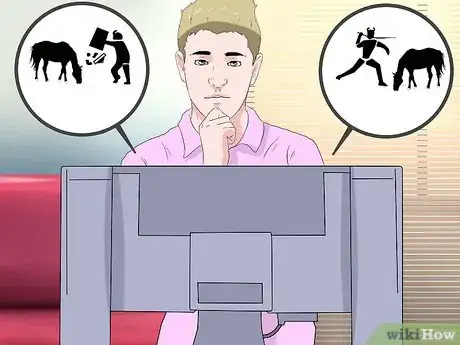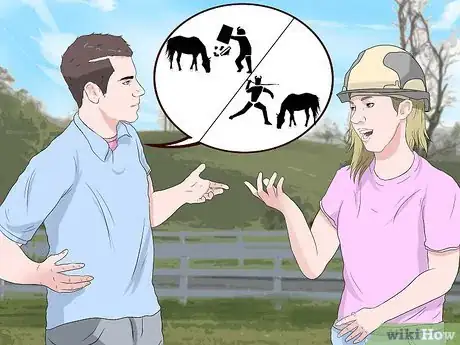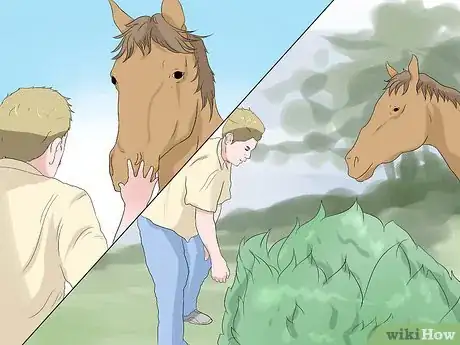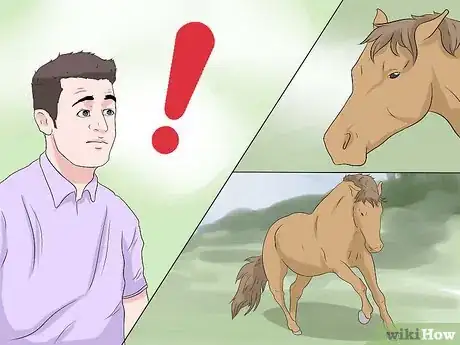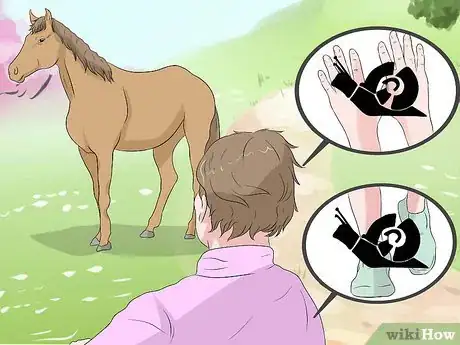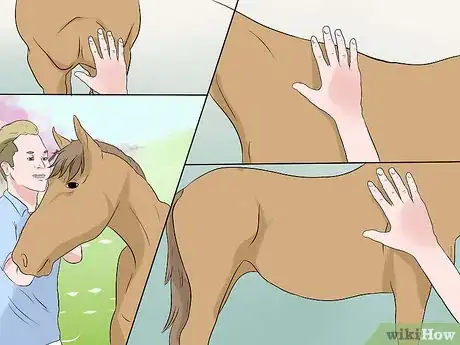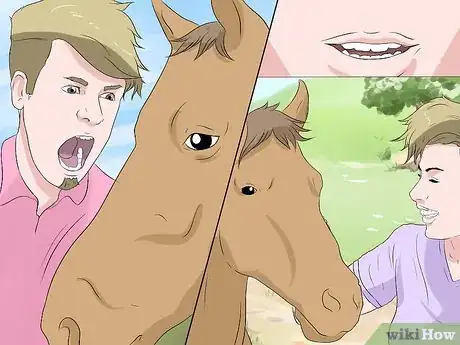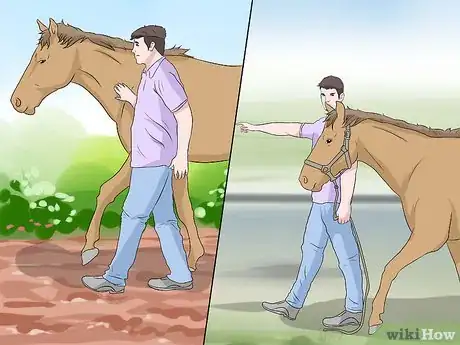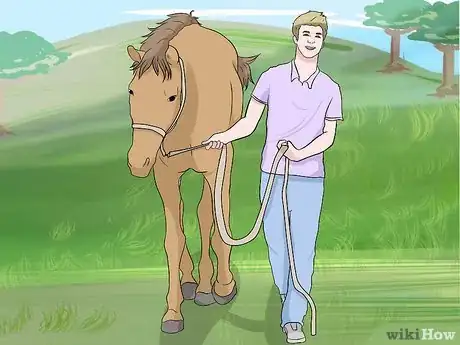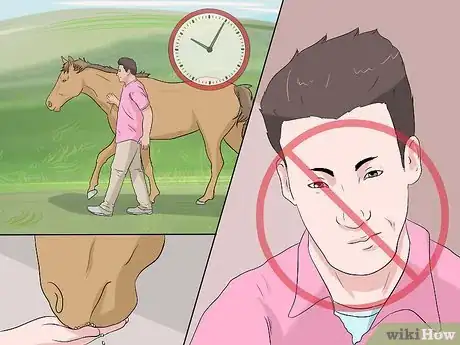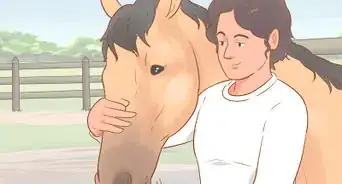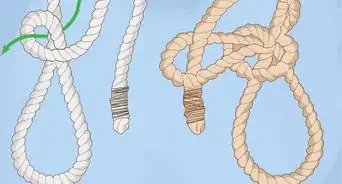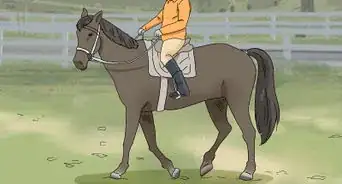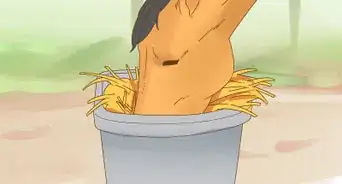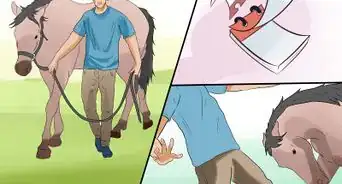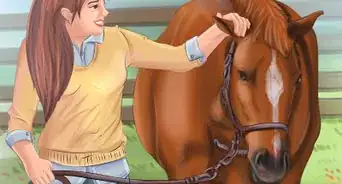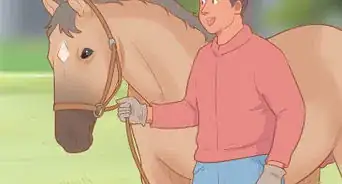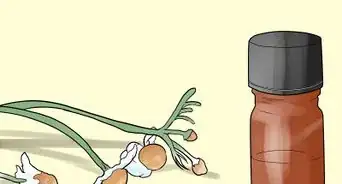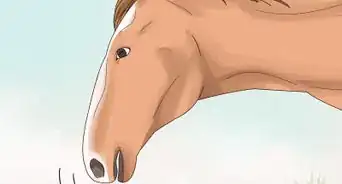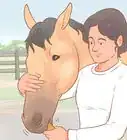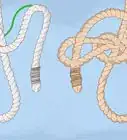This article was co-authored by Kate Jutagir. Kate Jutagir is an Equestrian Specialist, Hunter/Jumper Trainer, and the Owner of Blackhound Equestrian, a premier training barn located on 65 acres in Castro Valley, California. Originally designed to be a riding school used as a springboard for dedicated students into careers in the sport, Blackhound Equestrian has grown into a hunter/jumper training program for all levels focusing on providing a solid foundation needed for personal advancement in the sport. Kate has over 25 years of equestrian instruction and training experience. Her focus on developing horse and rider partnerships provides a complete equestrian education for both beginners and advanced riders alike.
This article has been viewed 125,331 times.
Adopting a recently abused horse can be a very rewarding experience. It gives the horse a new home and a caring owner, and you get the chance to bond with a special horse. Your relationship may even turn into a lifelong friendship. However, because an abused horse may have lost his trust in people, you will need to first take the time to gain his trust and make him feel comfortable and safe with you.
Steps
Learning About Your Abused Horse
-
1Learn about passive and active abuse. Before working to gain your abused horse’s trust, it will be important for you to understand what type(s) of abuse he suffered in the past. There are two types of abuse: passive and active. Passive abuse does not involve physical harm. Rather, it is characterized by neglect—lack of food, water, shelter, or veterinary care.[1]
-
2Ask questions about your horse’s past. Learning what type of abuse your horse endured will help you understand what kind of uphill battle you will face to gain his trust. Obtaining more information about his life as a whole will give you an even better idea of how to work with him. For example, you can ask more probing questions about his abuse: When did the abuse start? How long did it last? How severe was it?
- Consider asking what your horse is afraid of.[4]
- Ask about his prior veterinary care (e.g., deworming, vaccinations, dental exams).
- Try to learn more about his temperament: Is he aggressive? Does he startle easily?
- Finding out whether your horse has worked with an equine behaviorist would be helpful information.
- There are many questions you could ask the previous owner or rescue group to learn more about your horse. Ask as many questions as you can think of.
Advertisement -
3Identify what special needs your abused horse will need. Depending on the nature or severity of your horse’s recent abuse, he may have many special needs. For example, if he suffered from a lack of food and water, he will probably have specific dietary needs to help him put weight back on and correct nutritional deficiencies.[5]
- If he did not receive consistent veterinary care, he will probably need a number of veterinary services—deworming, vaccinations, dental exam, shoe trimming, etc.[6]
- Active abuse may have left him with physical injuries requiring veterinary care.
- Keep in mind that the effects of abuse may not be visible. He may have developed serious behavioral issues, which could necessitate the expertise of an equine behaviorist.[7]
- Consult with your veterinarian to determine what special needs will need to be addressed to get your horse back into good shape.[8]
-
4Become familiar with your abused horse’s other needs. Your recently abused horse will likely be emotionally fragile. Before he can even begin to trust you, he will need to feel emotionally safe and comfortable with you. In addition to this emotional comfort, he will need to regain a sense of companionship and routine.
- These needs are just as important as his more basic needs (e.g., food, water, shelter).
- Training exercises and quality time with your horse will help you address these needs.
Gaining the Trust of Your Recently Abused Horse
-
1Learn your horse’s body language. Being able to read your horse’s body language will allow to you communicate with him more effectively, which will in turn help you gain his trust. Your abused horse may demonstrate certain body language as a result of the abuse (e.g., trembling, tense muscles). The more you understand how he is feeling at any given moment, the better you will be able to address his abuse.
- Trembling is very common in abused horses. Your horse may begin to tremble and shake as you approach him, out of fear that you will hurt him.
- A trembling horse may be signaling that he is ready to bolt. Be prepared to quickly move to safety if your horse begins to tremble.
- An abused horse may also tense his muscles in response to being touched or approached.
- Physical abuse may have caused your horse to exhibit aggressive body language, such as striking with a front leg, swinging his hindquarters, and pinning back his ears. For your own safety, do not attempt to approach or work with your horse if he is being aggressive.
- Talk with your veterinarian or equine behaviorist if you are unsure how to read your horse’s body language.
-
2Learn the proper way to approach your horse. How you approach your abused horse is an important factor in whether you will gain his trust. Slow and easy movements are a must.[9] In addition, you should approach him from his side, not directly in front of him.[10]
- Approaching him from his front may look threatening to him, which may make him wary or afraid of you.
- Your body language (relaxed breathing, slow walk) should communicate that you are calm, confident and aware of your surroundings.
- Do not make direct eye contact with your horse as you approach him.[11]
- Wait a short distance away from your horse before approaching him. This will allow you to observe his body language and determine if he is ready for you to be in his personal space. If he looks relatively calm (e.g., ears turned to the side, lowered head, cocked hind leg), proceed with walking towards his side.
- Body language that signals fear or anxiety (e.g., ears cocked back, pawing at the ground, tightened facial muscles), indicates that your horse may not want to be approached.
- Consider the ‘advance and retreat’ method. Approach his side for a few seconds, then back away. Approach again, scratch his shoulder or withers, then back away again. Your horse will not only feel safe around you when you do this (predators don’t advance and retreat), but he will also be curious about you.
-
3Touch your horse. Your abused horse may be averse to being touched—he may equate this to physical pain and punishment. For this reason, you should be extremely careful with how and where you touch him. Begin by gently scratching his chest, shoulder, or withers.[12]
- Watch your horse’s body language as you touch him. An abused horse may be especially skittish and prone to making sudden movements. Staying aware of his body language will help you move out of the way quickly if you sense his fear and anxiety.
- As he becomes more comfortable with you, try touching him in different areas of his body, such as his neck and legs.[13]
- Avoid touching his face or head. Horses don’t particularly care for their noses being touched.[14]
- Do not be overly affectionate with your horse. Not only may he not be ready for it, but horses in general are not overly affectionate with each other.
-
4Talk to your horse. How you talk to your abused horse also plays a role in whether he will trust you. His previous owners may have constantly yelled at him, or avoided talking to him at all. Talking to your horse in a soothing and reassuring voice will go a long way towards gaining his trust.
Establishing Your Leadership With Your Horse
-
1Teach your horse to yield to pressure. In the wild, a herd of horses will have a leader that all other horses will follow. In order for your abused horse to trust you, he will need to see you as his leader who will protect and care for him. Teaching your horse to yield to direct and indirect pressure is a great way to establish that your leadership.
- With direct pressure, you will gently press your hand against your horse’s body until he moves away. Release the pressure immediately after he moves away.[17]
- For indirect pressure, you will attach a lead rope to your horse’s halter. Standing a few feet in front of him, point your index finger and wiggle the rope. Continue pointing and wiggling the rope until he begins to move back, then release the pressure.[18]
- Do not be surprised if your horse does not learn to yield to pressure right away. Be patient with him and talk to him in a reassuring voice. Eventually, he will learn how to respond correctly to pressure.
- Start with as little pressure as possible, then gradually increase the pressure with each practice session.
- Keep in mind that abused horses may be either hypersensitive to pressure or desensitized to it.
-
2Lead your horse. Leading your horse is another good way to establish that you are your horse’s leader. This type of training will teach your horse to respect your personal space and will help him trust and bond with you.[19]
- Leading your horse from the partner position is the safest and most preferable way to lead your horse. You can stand next to either of your horse’s shoulders, but it is customary to lead from a horse’s left shoulder.
- It may be helpful to hold your elbow out—this will lessen the chance of your horse knocking you over if he starts to get too close to you.[20]
- Be sure to coil the excess lead rope in your hand.[21] Do not wrap it around your hand or wrist. You may get dragged and seriously injured if he bolts and you are unable to free yourself from the lead rope.
- Leading your horse from his front (lead position) or back (drive position) is not recommended.[22]
-
3Be consistent. Establishing leadership with your horse will take consistent, daily practice. Because of the abuse he suffered, your horse may take a long time to accept your leadership and trust you. Do not become discouraged, though. The more consistent you are with your training, the more your horse will trust you and feel safe with you.
- Routines are very important to horses.
- Consistency also applies to other ways of interacting with your horse, including grooming him and feeding him.
EXPERT TIPKate Jutagir is an Equestrian Specialist, Hunter/Jumper Trainer, and the Owner of Blackhound Equestrian, a premier training barn located on 65 acres in Castro Valley, California. Originally designed to be a riding school used as a springboard for dedicated students into careers in the sport, Blackhound Equestrian has grown into a hunter/jumper training program for all levels focusing on providing a solid foundation needed for personal advancement in the sport. Kate has over 25 years of equestrian instruction and training experience. Her focus on developing horse and rider partnerships provides a complete equestrian education for both beginners and advanced riders alike.Equestrian Specialist & Trainer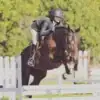
 Kate Jutagir
Kate Jutagir
Equestrian Specialist & TrainerExpert Warning: If you are having serious trouble gaining your horse's trust, you might want to seek the help of a professional. Look up trainers and veterinarians in your area and see if they are able to come to help you figure out the best path forward with your horse.
Expert Q&A
-
QuestionHow do you help a horse that has been abused?
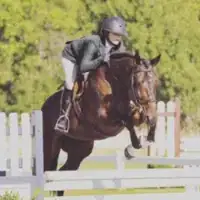 Kate JutagirKate Jutagir is an Equestrian Specialist, Hunter/Jumper Trainer, and the Owner of Blackhound Equestrian, a premier training barn located on 65 acres in Castro Valley, California. Originally designed to be a riding school used as a springboard for dedicated students into careers in the sport, Blackhound Equestrian has grown into a hunter/jumper training program for all levels focusing on providing a solid foundation needed for personal advancement in the sport. Kate has over 25 years of equestrian instruction and training experience. Her focus on developing horse and rider partnerships provides a complete equestrian education for both beginners and advanced riders alike.
Kate JutagirKate Jutagir is an Equestrian Specialist, Hunter/Jumper Trainer, and the Owner of Blackhound Equestrian, a premier training barn located on 65 acres in Castro Valley, California. Originally designed to be a riding school used as a springboard for dedicated students into careers in the sport, Blackhound Equestrian has grown into a hunter/jumper training program for all levels focusing on providing a solid foundation needed for personal advancement in the sport. Kate has over 25 years of equestrian instruction and training experience. Her focus on developing horse and rider partnerships provides a complete equestrian education for both beginners and advanced riders alike.
Equestrian Specialist & Trainer I would recommend reading lots of books about how horses are started and trained, and really understanding their reactions and behaviors Work with professionals and veterinary staff to make sure first and foremost that the horse is comfortable. Then go very, very slowly, taking your time with an abused horse, and just start from the basics. Start from wherever they'll let you, leading, handling, and eventually I would recommend that you start with a professional riding them before you mount them.
I would recommend reading lots of books about how horses are started and trained, and really understanding their reactions and behaviors Work with professionals and veterinary staff to make sure first and foremost that the horse is comfortable. Then go very, very slowly, taking your time with an abused horse, and just start from the basics. Start from wherever they'll let you, leading, handling, and eventually I would recommend that you start with a professional riding them before you mount them. -
QuestionThere are 5 horses down the road near me. Their pasture has no grass, there's not enough land, you can see their ribs, and they have no shelter. What can I do without getting the owners in trouble?
 Community AnswerI don't think you can do this without getting the owners in trouble, but honestly you shouldn't be concerned about that. They're obviously neglecting their horses and they should face the consequences for that neglect. Call your local ASPCA or animal rehabilitation center and explain the situation.
Community AnswerI don't think you can do this without getting the owners in trouble, but honestly you shouldn't be concerned about that. They're obviously neglecting their horses and they should face the consequences for that neglect. Call your local ASPCA or animal rehabilitation center and explain the situation. -
QuestionHow can I put a halter on a horse who has been traumatized?
 Community AnswerStart by building a relationship with the horse and gaining his trust. This may take time and patience. Once you are able to touch the horse without a negative reaction, slowly introduce the halter. Let him see it and smell it before you gently try to put it on.
Community AnswerStart by building a relationship with the horse and gaining his trust. This may take time and patience. Once you are able to touch the horse without a negative reaction, slowly introduce the halter. Let him see it and smell it before you gently try to put it on.
Warnings
- Remain alert at all times when you are around your horse.[24] His previous abuse may cause him to react unpredictably and dangerously.⧼thumbs_response⧽
References
- ↑ http://www.petful.com/animal-welfare/adopt-an-abused-horse/
- ↑ http://www.petful.com/animal-welfare/adopt-an-abused-horse/
- ↑ http://www.petful.com/animal-welfare/adopt-an-abused-horse/
- ↑ http://www.petful.com/animal-welfare/adopt-an-abused-horse/
- ↑ http://www.petful.com/animal-welfare/adopt-an-abused-horse/
- ↑ http://www.petful.com/animal-welfare/adopt-an-abused-horse/
- ↑ http://www.petful.com/animal-welfare/adopt-an-abused-horse/
- ↑ http://www.petful.com/animal-welfare/adopt-an-abused-horse/
- ↑ http://www.horsechannel.com/horse-community/rescue-horse-care-7478.aspx
- ↑ http://www.horsechannel.com/horse-community/rescue-horse-care-7478.aspx
- ↑ http://www.horsechannel.com/horse-community/rescue-horse-care-7478.aspx
- ↑ http://www.horsechannel.com/horse-community/rescue-horse-care-7478.aspx
- ↑ http://www.horsechannel.com/horse-community/rescue-horse-care-7478.aspx
- ↑ http://www2.ca.uky.edu/agc/pubs/4af/4af05ma/4af05ma.htm
- ↑ http://www.horsechannel.com/horse-community/rescue-horse-care-7478.aspx
- ↑ http://www.horsechannel.com/horse-community/rescue-horse-care-7478.aspx
- ↑ http://www.equusite.com/articles/ground/groundRespect.shtml
- ↑ http://www.equusite.com/articles/ground/groundRespect.shtml
- ↑ https://naturalhorsemanship.wordpress.com/what-is-natural-horsemanship/
- ↑ http://www2.ca.uky.edu/agc/pubs/4af/4af05ma/4af05ma.htm
- ↑ http://www2.ca.uky.edu/agc/pubs/4af/4af05ma/4af05ma.htm
- ↑ http://www2.ca.uky.edu/agc/pubs/4af/4af05ma/4af05ma.htm
- ↑ http://www.horsechannel.com/horse-community/rescue-horse-care-7478.aspx
- ↑ http://www.horsechannel.com/horse-community/rescue-horse-care-7478.aspx
About This Article
To gain the trust of a recently abused horse, approach it from its side rather than head on, which will be less threatening to the horse. If you see signs of stress, like trembling or tense muscles, back away or stand still until the horse calms down. Once you're right next to the horse, try talking to it in a soothing voice to reduce its anxiety levels. Additionally, spend time with it every day so it can get used to being around you, which will make it feel safe. For tips from our Veterinary co-author on how to lead your horse, keep reading!
